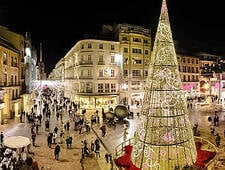With the Easter holidays in Spain just around the corner, discovering the colorful culture and Easter traditions in Spain is an exciting thing to do in the Spring season.
.jpg) Each year on Easter, Christians commemorate the fragments of Jesus’ life, including the Passion of Christ and the Resurrection of Jesus. The last procession finalizes the holiday on Easter Sunday. This last event of the holiday is the most significant one, focusing on the Resurrection of Jesus.
Each year on Easter, Christians commemorate the fragments of Jesus’ life, including the Passion of Christ and the Resurrection of Jesus. The last procession finalizes the holiday on Easter Sunday. This last event of the holiday is the most significant one, focusing on the Resurrection of Jesus.
Even non-Christians are familiar with the concept of Easter. Since it has been the subject of numerous TV shows or movies produced in the US, most of the world is familiar with American traditions. Spaniards’ approach to Easter is a bit different than well-known US traditions.
Easter bunnies or egg decorations are widely known all over the world, but do they have Easter eggs in Spain? And what about Spanish Pasos or Málaga’s colorful parades? And how do they celebrate Easter in Spain? Let’s dive into the essentials of Spanish Easter!
When is Easter Celebrated in Spain?
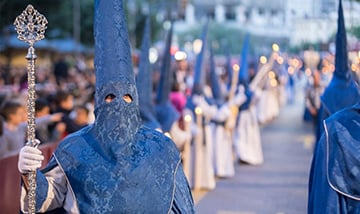 The Holy Week and Easter are celebrated during the Spring season, slightly after the Spring equinox. It usually falls between the last weeks of March and the first days of April in Spain.
The Holy Week and Easter are celebrated during the Spring season, slightly after the Spring equinox. It usually falls between the last weeks of March and the first days of April in Spain.
However, the exact dates can change each year. Since it must be calculated by the Gregorian calendar and the full moon, Easter is considered a moveable feast.
The Easter processions in Spain start with Palm Sunday, also known as Domingo de Ramos. It lasts the whole week and ends with Easter Sunday or Lunes de Pascua in Spanish.
How is Easter Celebrated in Spain?
On Easter, the Resurrection of Jesus is commemorated with colorful events including parades with Pasos, and marches.
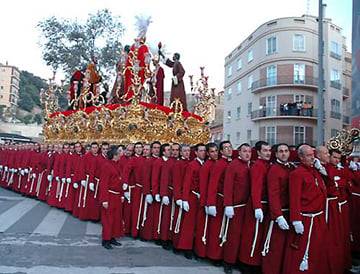 On Palm Sunday, the Holy Week begins with church rituals, processions, and distributions of sanctified palm leaves. Each day of the Semana Santa, parades take place all over Spain. The most spectacular Easter parades in Spain are organized in Andalucia, especially in Málaga city.
On Palm Sunday, the Holy Week begins with church rituals, processions, and distributions of sanctified palm leaves. Each day of the Semana Santa, parades take place all over Spain. The most spectacular Easter parades in Spain are organized in Andalucia, especially in Málaga city.
During these Easter processions in Spain, people carry wooden arrangements called Pasos through the main streets. These Pasos are glorified sculpture-like icons portraying the Passion of Christ. In Málaga, the whole crowd marches down the streets with shiny Tronos. These Tronos are mostly palanquin-like structures painted in gold and various color, adorned with candles and flowers.
The religious brotherhoods are a big part of Semana Santa masses. You can come across a group of people wearing identical clothes, carrying Tronos or Pasos. They are usually dressed in shiny, colorful silk costumes with pointed headpieces. These are known as religious brotherhoods or Cofradía in Spanish.
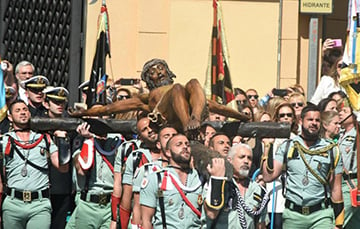 Each autonomous community, even the city, hues a different holiday spirit around Easter. The most glamorous and monumental events mostly take place in Andalucia. Málaga and Seville rank as the best places to experience the Easter spirit. They’re followed by Jerez de la Frontera, Granada, Castilla y Leon, Zamora, and Valladolid.
Each autonomous community, even the city, hues a different holiday spirit around Easter. The most glamorous and monumental events mostly take place in Andalucia. Málaga and Seville rank as the best places to experience the Easter spirit. They’re followed by Jerez de la Frontera, Granada, Castilla y Leon, Zamora, and Valladolid.
The Easter Egg represents the resurrection of Christ and is mostly chosen as one of the attributes of the holiday. Hard-boiled eggs are distributed during the parades in Murcia, used as decorations, or even become a part of the best holiday dishes.
Also, it may be surprising to see fewer Easter eggs and giant bunny decorations throughout the cities of Spain. The main reason is that Spanish Easter is a more religious and spiritual holiday rather than a festival. Almost all Spaniards join the gatherings and events, however, more likely to send prayers and commemorate Christ.
The final day of the Semana Santa, Easter Sunday in Spain, is mostly spent with families and loved ones. In some regions of Spain, people participate in Easter masses in the mornings. Then, they meet at the table upon return to enjoy the traditional Easter meals, especially the famous Easter cake called Mona de Pascua.
Traditional Easter Dishes in Spain
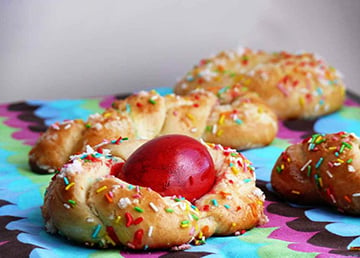 The most traditional Easter foods in Spain are the famous Easter eggs, Mona de Pascuas, Torrijas, and Bueñuelos. But also, there are subsidiary additional dishes such as the Sopa de Ajo, or Flores Fritas de Semana Santa.
The most traditional Easter foods in Spain are the famous Easter eggs, Mona de Pascuas, Torrijas, and Bueñuelos. But also, there are subsidiary additional dishes such as the Sopa de Ajo, or Flores Fritas de Semana Santa.
The famous chocolate Easter egg is called Huevos de Pascua in Spain. It is one of the most essential desserts of the holiday. These egg-shaped chocolates are made with specific molds and filled with sweets and candies.
Bueñelos are deep-fried bite-size doughnuts with irregular shapes. Not only on Easter but Bueñelos are also essential dishes for other holidays in Spain, especially in Valencia.
Sopa de Ajo is also a famous garlic soup, usually eaten on the morning of Good Friday during Easter Week in Spain. The soup is made with chicken stock, paprika, and eggs on some occasions. It’s even tastier when served with croutons.
Torrijas are also another Easter dish placed on the table during the Semana Santa. They are pretty similar to French toast, but only the Spanish version of it. There are a few differences, such as the frying method or ingredients. In some regions of Spain, such as Seville, people use wine instead of milk, which creates a remarkable difference.
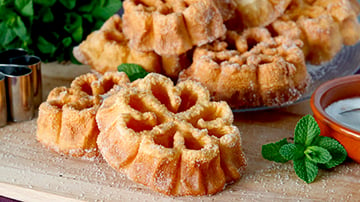 Here is the most aesthetic dish of the season: Flores Fritas de Semana Santa. It is an amazing reputation in Castilla y Leon and bears a significant resemblance to Calatrava Cross. It’s also one of the most delicious snacks to taste during Easter in Spain.
Here is the most aesthetic dish of the season: Flores Fritas de Semana Santa. It is an amazing reputation in Castilla y Leon and bears a significant resemblance to Calatrava Cross. It’s also one of the most delicious snacks to taste during Easter in Spain.
Mona de Pascua is a must-have at Easter dinners. This is the traditional easter cake, mostly famous around Catalonia, Valencia, and Murcia. Mona de Pascuas mostly are made as ring-shaped sweet bread decorated with whole eggs on top or in the middle. There are variations of it, in some places it might be covered in chocolate, sprinkles, or candies.
Pro Tip for Travellers: People sometimes wonder, are shops open in Spain on Easter Monday? Around holidays; all public institutions, attractions, streets, and private establishments might be closed. If you are considering some sightseeing or visiting museums around the holidays, you may be disappointed.
Same as the Easter egg, your dream life is also hidden somewhere in Spain, waiting to be found. Instead of the same old egg hunt, go for a property hunt in Spain this Easter to live your best life under the sun!


